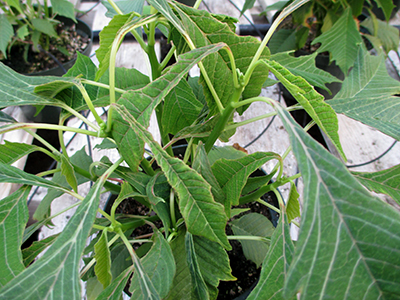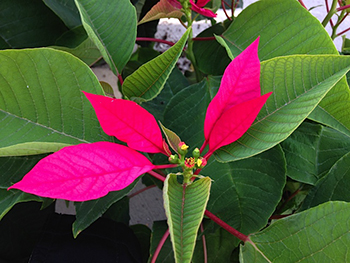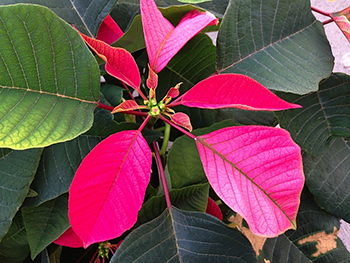It’s getting hot in here: High temperature stress on poinsettias
Regulate the environment in your greenhouse to prevent reduced poinsettia crop quality and heat delay.

Poinsettia is typically propagated during the hottest months of the year. Be careful to prevent excessively high temperatures in the greenhouse and any rapid temperature swings. Michigan State University Extension reminds growers that extreme temperatures in the greenhouse can cause scheduling complications and growth distortion on poinsettia crops.
While temperatures in Michigan were cooler than average in July, poinsettia growers should continue to monitor and regulate greenhouse temperatures, especially at night. Heat delay can result from temperatures over 74 degrees Fahrenheit at night (Photo 1). Also, growers should be aware of microclimates that develop in the greenhouse, especially where air movement is limiting. For example, poinsettias placed too close to heat pipes can be delayed by two weeks or even longer.
In addition to scheduling complications, excessively high temperatures can also cause abnormal development of leaves and bracts and even blind shoots. Blind shoots are those without lateral buds, which means branches cannot develop from those buds. However, this is usually only a problem during stock plant production. Poinsettias can also develop strap-like leaves and distorted growth when grown at high temperatures (Photo 2). Severely affected plants are unsalable.

Photo 2. Distorted growth on poinsettia as a result of high temperature stress. Photo credit: Heidi Wollaeger, MSU Extension
High temperatures can also cause premature cyathia abscission (Photo 3) or poor bract development (Photo 4), which can reduce the marketability of the crop. Growers can prevent cyathia abscission and poor bract development by reducing night temperatures to between 60 and 65 F, allowing for proper spacing and providing adequate water and sufficient air flow. In addition, ensure the electrical conductivity (EC) of the media is lower, for example around 1.0 to 1.2, using the saturated media extract method prior to shipping.


Photos 3-4. Left, Poinsettia with reduced cyathia formation. Right, Poor bract formation on poinsettia exposed to high temperature stress. Photo credits: Heidi Wollaeger, MSU Extension
For more information about poinsettia heat stress and disorders, see “Physiological Disorders of Poinsettias,” written by Brian Whipker from North Carolina State University. As temperatures begin to cool off this fall, consider using a guide on temperature regulation and scheduling for energy efficient poinsettia production by Erik Runkle from MSU and Jim Faust of Clemson University.
Dr. Runkle’s work is funded in part by MSU’s AgBioResearch.



 Print
Print Email
Email

